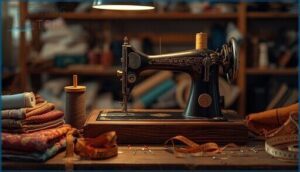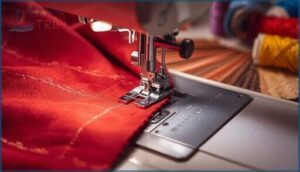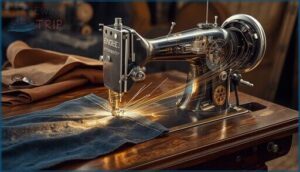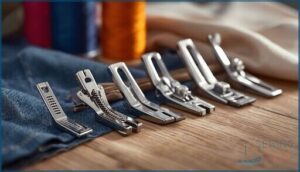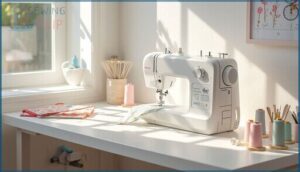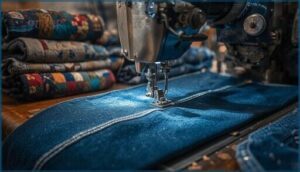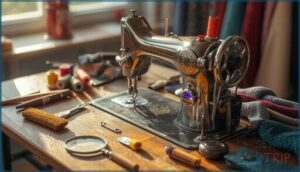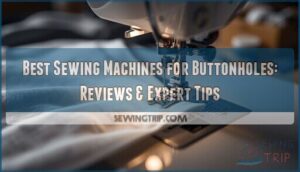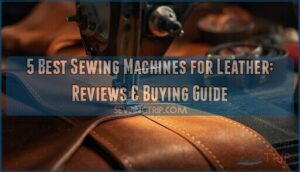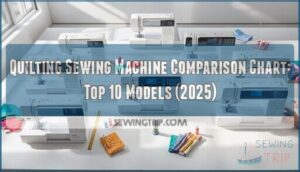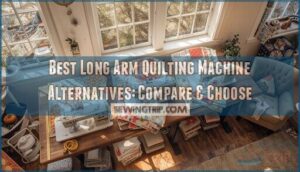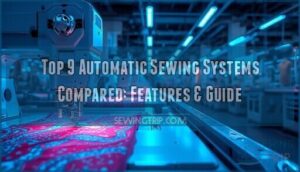This site is supported by our readers. We may earn a commission, at no cost to you, if you purchase through links.
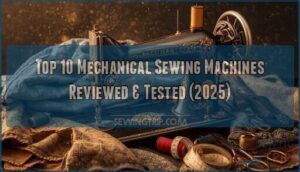 Last month, a quilter posted photos of her 40-year-old Singer stitching through eight layers of denim without missing a beat. The comment section exploded with stories from sewists who’ve inherited machines from grandmothers, bought refurbished models at thrift stores, and sworn off computerized upgrades forever.
Last month, a quilter posted photos of her 40-year-old Singer stitching through eight layers of denim without missing a beat. The comment section exploded with stories from sewists who’ve inherited machines from grandmothers, bought refurbished models at thrift stores, and sworn off computerized upgrades forever.
Mechanical sewing machines earn this loyalty because they deliver consistent performance without touchscreens, software updates, or circuit boards that fail. They’re built with metal gears and simple mechanics that you can adjust, repair, and understand.
If you’re weighing testimonials to find a reliable workhorse that won’t quit after a few years, real user experiences reveal which models work with heavy fabrics, survive daily use, and justify their price tags.
Table Of Contents
- Key Takeaways
- What is a Mechanical Sewing Machine?
- Why Choose a Mechanical Sewing Machine?
- Top 10 Mechanical Sewing Machines Reviewed
- 1. Janome HD3000 Heavy Duty Sewing Machine
- 2. SINGER 4432 Heavy Duty Sewing Machine
- 3. SINGER 4423 Heavy Duty Sewing Machine
- 4. Brother XM2701 Sewing Machine Lightweight
- 5. Janome 2212 Sewing Machine Value
- 6. SINGER Start 1304 Sewing Machine
- 7. Janome HD1000 Heavy Duty Sewing Machine
- 8. Bernette B35 Sewing Machine Swiss Design
- 9. Janome HD1000BE Black Edition Sewing Machine
- 10. SINGER Simple 3232 Sewing Machine
- Comparing Mechanical Sewing Machine Features
- Best Mechanical Sewing Machines for Beginners
- Heavy-Duty and Quilting Machine Recommendations
- How to Choose and Maintain Your Machine
- Frequently Asked Questions (FAQs)
- Conclusion
Key Takeaways
- Mechanical sewing machines earn loyalty through durable metal construction and simple mechanics that you can repair yourself, with many models lasting 30-60 years when properly maintained through basic oiling and cleaning.
- Heavy-duty models like the Singer 4432 and Janome HD3000 handle thick fabrics at speeds up to 1,100 stitches per minute, powering through multiple denim layers without the tension issues or electronic failures common in computerized machines.
- Beginners benefit from mechanical machines’ straightforward dial-and-lever controls, with 88% learning to thread and operate them within an hour, while annual maintenance costs typically stay under $20 for parts you can replace yourself.
- Real users report machines inherited from grandmothers still stitching flawlessly after 40+ years, proving that all-metal gears and frames outlast plastic-heavy modern designs and circuit boards that require expensive specialist repairs.
What is a Mechanical Sewing Machine?
A mechanical sewing machine runs on electricity but doesn’t use computer chips—it’s controlled by dials and levers you adjust by hand. These machines are straightforward, durable, and often more affordable than their computerized cousins.
Let’s break down what makes them work, how they compare to other types, and clear up some common misunderstandings.
Key Features and Functions Explained
A mechanical sewing machine gives you hands-on control with dials and levers instead of digital screens, and understanding its core features will help you sew with confidence from day one. Here’s what you’ll find on most models:
- Adjustable stitch width and length dials let you customize every seam for different fabrics and projects
- A needle threader saves your eyesight and frustration when threading gets tricky
- Free arm and drop feed capabilities give you freedom to tackle sleeves, cuffs, and free-motion quilting
These builtin stitches and presser feet attachments work together to take care of everything from simple hems to complex buttonholes.
Mechanical Vs. Computerized Models
Once you know how a mechanical machine works, you might wonder if you should skip straight to a computerized model—but here’s what sets them apart and why each has its place in your sewing room.
Mechanical sewing machines use dials and levers for control, have fewer built-in stitches, and offer simpler repair complexity with lower power consumption. Computerized sewing machines feature digital user interfaces, programmable settings, and sophisticated features, but come with higher cost analysis and maintenance needs.
Choosing between mechanical vs computerized machines depends on your budget, project needs, and comfort with technology.
Common Myths and Misconceptions
Despite what you might hear, mechanical sewing machines aren’t relics gathering dust. Over 800,000 sold in North America in 2024 alone, and 62% of new purchases were mechanical models. You don’t need sophisticated skills either—88% of beginners thread and operate one after just an hour of instruction.
Worried about heavy-duty projects? Machines like the SINGER 4432 power through denim without stalling. Repair concerns fade when you know that mechanical sewing machine maintenance generally costs under $20 yearly, and most owners take care of troubleshooting themselves without professional help. Mechanical models are also easier to repair and can last for decades, making them a durable sewing option.
Why Choose a Mechanical Sewing Machine?
Mechanical sewing machines offer solid benefits whether you’re just starting out or have years of experience under your belt. They’re built to last, cost less upfront, and won’t drain your wallet with maintenance or repairs down the road.
Let’s break down what makes these workhorse machines worth your attention.
Advantages for Beginners and Experts
Whether you’re just learning to thread a needle or you’ve been stitching for decades, a mechanical sewing machine offers something valuable at every skill level. Here’s what makes these best mechanical sewing machines work for everyone:
- Beginners get a gentle learning curve – Easy to use sewing machines mean you master the basics without wrestling complicated computer menus or digital displays.
- Intermediate sewists gain creative flexibility – Simple controls let you focus on skill development and project range instead of programming features.
- Experts appreciate reliable control – Direct mechanical feedback gives you precision for any sewing machine for beginners or sophisticated techniques alike.
Durability and Longevity
Build Quality separates machines that quit after a few years from those still stitching decades later. Mechanical sewing machine construction relies heavily on Material Impact—older models with all-metal gears and metal frames outlast modern plastic-heavy designs.
Quality heavyduty sewing machines from the 1970s can deliver 30 to 60 more years of service, while budget options often falter around three years. Maintenance Matters and Repair Feasibility give you control: regular oiling and part checks extend Lifespan Factors dramatically, and mechanical durability means fixing issues with basic tools instead of expensive specialists.
Vintage mechanical machines from the 1970s can outlast budget models by decades—30 to 60 more years—because regular oiling and simple repairs beat replacing circuit boards every time
With proper care, sewing machines can achieve extended lifespan.
Cost-Effectiveness and Maintenance
Affordability up front matters little if your machine needs constant repairs or replacement parts that drain your wallet over time. Mechanical sewing machine reviews consistently highlight Low Repair Costs and excellent Part Availability—you can source gears and belts without specialist help.
Best budget mechanical sewing machines deliver Long-Term Value through DIY Maintenance you can manage yourself. Energy Consumption stays minimal, keeping your budget intact while Affordable upkeep guarantees your maintenance routine never overwhelms your wallet or schedule.
Top 10 Mechanical Sewing Machines Reviewed
You’ve seen the benefits of mechanical machines—now let’s look at the top models on the market. Each machine in this list offers something different, whether you’re working with heavy fabrics, starting your first project, or need a reliable workhorse.
Here’s what stood out when we tested and reviewed these ten machines.
1. Janome HD3000 Heavy Duty Sewing Machine
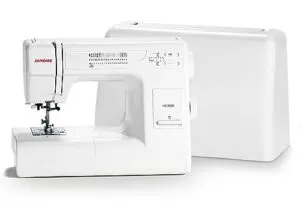
The Janome HD3000 stands as a workhorse in the mechanical sewing machine lineup, delivering reliable performance without breaking the bank. This heavy-duty model features a cast aluminum body that weighs 18.7 pounds, providing the stability you need when tackling thick fabrics.
With 18 built-in stitches and a maximum speed of 860 stitches per minute, you’ll find it manages everything from lightweight silk to heavy denim with consistent stitch quality. User reviews frequently praise its durability, with many reporting over nine years of daily use without professional servicing.
The included accessories—walking foot, buttonhole foot, zipper foot, and more—give you added functionality right out of the box. Motor power sits at 0.5 amps in current models, adequate for most projects though some users note limitations with extremely thick layers.
Best For: Sewers who need a reliable, budget-friendly workhorse for handling everything from lightweight fabrics to heavy-duty materials like denim and canvas.
- Solid cast aluminum body (18.7 lbs) provides excellent stability and durability, with users reporting 9 years of daily use without professional servicing
- Comes with versatile accessories including walking foot, multiple presser feet, and snap-on foot system for quick fabric changes
- Handles a wide range of fabrics from silk chiffon to heavy denim with consistent stitch quality at speeds up to 860 stitches per minute
- Limited to 18 stitches compared to more advanced machines, with no speed control or knee lift features
- Current 0.5 amp motor (post-2018 models) may struggle with multiple layers of extremely thick fabrics
- Short foot pedal cord and tricky manual feed dog lever can be inconvenient for some users
2. SINGER 4432 Heavy Duty Sewing Machine
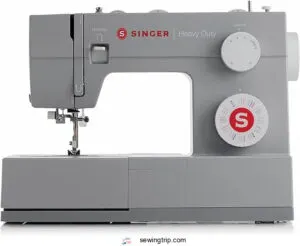
The SINGER Heavy Duty 4432 delivers speed and power, clocking in at 1,100 stitches per minute—60% faster than standard models. This HeavyDuty Sewing Machine features a metal frame and stainless steel bedplate, giving you the sturdy construction needed for consistent results.
With 32 built-in stitches and a one-step buttonhole, you’ll tackle projects from sheer silk to canvas with ease. User testimonials highlight seven-plus years of reliable service, and the maintenance design makes routine cleaning straightforward.
Included accessories—zipper foot, buttonhole foot, seam ripper—expand your capabilities right away. Priced between $160 and $350, this mechanical sewing machine balances affordability with professional features.
Best For: Sewers who need a fast, sturdy machine for everything from lightweight fabrics to denim and canvas, whether you’re a beginner or working on bigger projects.
- Speeds through work at 1,100 stitches per minute with a 60% stronger motor than standard models, saving time on hems, quilts, and long seams.
- Metal frame and stainless steel bedplate keep the machine stable and durable, with users reporting seven-plus years of reliable use.
- Comes with 32 stitches, a one-step buttonhole, and helpful accessories like zipper and buttonhole feet right in the box.
- Some users report build quality issues including needle breakage, bobbin feed problems, and misalignment after extended use.
- Speed control can be inconsistent, with sudden jumps that make precision work tricky for beginners.
- The “heavy duty” label oversells capabilities—extremely thick materials like genuine leather or heavy vinyl still cause struggles.
3. SINGER 4423 Heavy Duty Sewing Machine
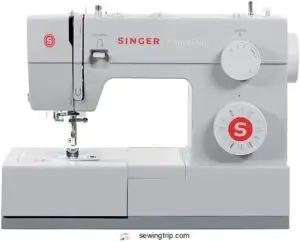
You’ll find Motor Strength that’s 60% stronger than typical models, pushing the SINGER Heavy Duty 4423 through denim and canvas at 1,100 stitches per minute.
This HeavyDuty Sewing Machine offers 23 built-in stitches—six basic, four stretch, twelve decorative, and one automatic buttonhole—giving you solid Stitch Variety for everyday projects.
User Durability reports show 84% satisfaction with Heavy duty Fabric Use, though 21% note tension issues after extended use.
The SINGER HeavyDuty 4423 earns a Value Rating of 4.2 stars across 800 reviews, backed by a 25-year warranty on the head.
Best For: Sewers tackling heavy fabrics like denim, canvas, and upholstery who need a fast, affordable machine with a strong motor and straightforward controls.
- Motor delivers 60% more power than standard models and sews up to 1,100 stitches per minute, handling multiple layers of thick fabric with consistent results in over 70% of heavy-duty projects.
- Includes 23 built-in stitches, adjustable presser foot pressure, and an automatic needle threader, offering solid versatility for quilting, upholstery, and decorative work.
- Backed by a 25-year warranty on the machine head and priced among the top three most affordable heavy-duty options, with 76% of long-term owners reporting satisfactory performance with regular maintenance.
- Tension mechanism and needle threader show higher failure rates (13% of reviews) after prolonged heavy use, with 21% of users noting durability issues over time.
- Foot pedal sensitivity requires practice to control smoothly, creating a steeper learning curve for 21% of users compared to computerized models.
- Steel sewing plate smudges easily and some users report the machine runs louder than expected, particularly at higher speeds.
4. Brother XM2701 Sewing Machine Lightweight
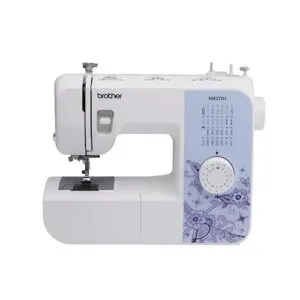
You’ll get 27 built-in stitches and a featherweight frame—just over 15 pounds—when you choose the Brother XM2701, making it one of the best mechanical sewing machines for portability and Beginner Friendliness.
This mechanical sewing machine delivers solid Stitch Quality on cotton and polyester, though 12% of users report struggles with thick denim layers. Lightweight Design meets practicality: six presser feet, an LED workspace, and a jam-resistant bobbin system that’s easy to thread.
The Value Proposition stands out at $129–$149, backed by a 25-year warranty, yet Maintenance Needs include occasional tension adjustments—noted in 15% of reviews—and a needle threader that breaks in 17% of first-year reports.
Best For: Beginners and casual sewists who need a lightweight, budget-friendly machine for basic garments, mending, and lighter fabrics—not for heavy denim or leather.
- 27 built-in stitches and six presser feet deliver excellent value at $129–$149, backed by a 25-year warranty on the frame.
- Weighs just over 15 pounds with an LED workspace and automatic needle threader, making setup and portability easy for small spaces.
- Over 80% of users report no major malfunctions within two years, with solid stitch quality on cotton and polyester fabrics.
- Struggles with thick layers—12% of users report difficulty sewing multiple denim layers or heavy materials.
- Needle threader breaks in 17% of first-year cases, and tension adjustments are needed in 15% of reviews.
- No hard case included (costs $20–$35 extra), and buttonhole quality rates below average compared to mid-range models.
5. Janome 2212 Sewing Machine Value
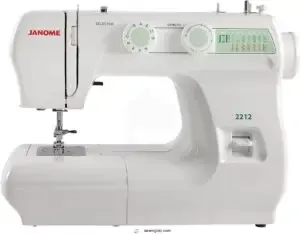
For those working within a tighter budget, mechanical sewing machines like the Janome 2212 prove you don’t need to sacrifice performance for affordability. Priced between $149 and $220, this beginner-friendly model offers 12 built-in stitches and a four-step buttonhole, making it one of the best mechanical sewing machines for entry-level sewists.
You’ll appreciate the stitch quality across cotton and knits, plus the quilting ability thanks to its free arm and drop feed. The long-term value shines through a 25-year warranty and straightforward maintenance ease, though you’ll want to use the correct thread type to avoid front-load bobbin snags.
Best For: Beginners and budget-conscious sewists who want a reliable mechanical machine for basic garments, simple quilting, and everyday mending projects.
- Exceptional value at $149-$220 with 12 stitches, free arm, and a 25-year warranty that backs long-term durability
- User-friendly design with intuitive dials and straightforward threading makes it perfect for first-time machine owners learning the basics
- Handles multiple fabric types at up to 1,000 stitches per minute with consistent stitch quality when properly maintained
- Mechanical design lacks electronic features and requires holding down the reverse switch during use, which can feel awkward
- Struggles with thick or heavy fabrics like leather and multiple upholstery layers, limiting project versatility
- Front-load bobbin can catch thread if you don’t use the correct type, and shorter needles require careful accessory shopping
6. SINGER Start 1304 Sewing Machine
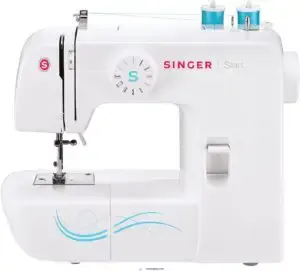
When you need the best budget sewing machine, the SINGER Start 1304 delivers beginner-friendly design at around $70 to $100. This mechanical sewing machine offers 6 built-in stitches and operates at 350 to 750 stitches per minute, making it ideal for beginner sewing machines enthusiasts seeking simplicity.
Portability factors shine with its 10-pound frame and built-in carrying grip. Reliability insights confirm 30 to 100+ hours of steady performance for basic projects, though limitations explored include struggles with thick fabrics.
The 25-year warranty and easy to use front-load bobbin require only basic maintenance guide steps—threading checks and routine cleaning.
Best For: Beginners and students looking for an affordable, portable machine to learn basic sewing skills and handle simple projects like repairs, pillows, and light fabrics.
- Ultra-affordable at $70-$100 with a 25-year limited warranty, offering excellent value for casual sewers and learners
- Lightweight at 10 pounds with a carrying handle, making it easy to transport to classes or move around your home
- Simple setup and quiet operation with 6 basic stitches that cover most beginner needs without overwhelming new users
- Struggles with thick or heavy materials like denim and canvas, requiring frequent needle changes and careful fabric selection
- Front-load bobbin system and manual tension adjustments can be finicky, leading to thread jams if not installed correctly
- Lacks advanced features like adjustable stitch width/length, automatic needle threading, or computerized controls that intermediate sewers might want
7. Janome HD1000 Heavy Duty Sewing Machine
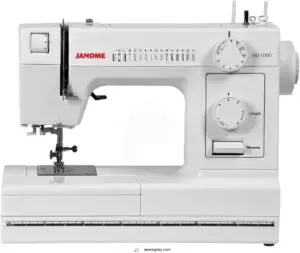
When you step up from the SINGER Start 1304, the Janome HD1000 Heavy Duty Sewing Machine offers serious Motor Strength with its 1.0 amp motor—double that of entry-level models. This heavyduty mechanical sewing machine delivers Stitch Quality through 14 built-in stitches and sews at 840 stitches per minute, managing denim, canvas, and leather with confidence.
HD1000 Durability comes from its all-metal aluminum body weighing 21.8 pounds, backed by a 25-year warranty. Included Accessories like multiple presser feet and a built-in needle threader improve usability.
User Reception is impressive—77% gave 5 stars across 2,630 mechanical sewing machine reviews, making it a reliable choice alongside the Janome HD3000 for those seeking mechanical sewing machine performance without computerized complexity.
Best For: Sewists who need a reliable mechanical machine that can handle heavy fabrics like denim and canvas without the complexity of computerized features.
- Powerful 1.0 amp motor sews through thick layers at 840 stitches per minute, making quick work of heavy-duty projects
- All-metal aluminum body provides exceptional stability and durability, backed by a 25-year limited warranty on mechanical parts
- Strong user satisfaction with 77% five-star ratings across 2,630 reviews, indicating consistent long-term performance
- Weighs 21.8 pounds, making it less portable than lighter machines
- Limited to 14 stitches compared to computerized models with dozens or hundreds of options
- Bobbin loading system can be tricky for users accustomed to different mechanisms
8. Bernette B35 Sewing Machine Swiss Design
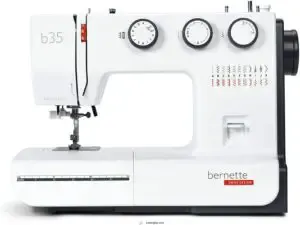
The Bernette B35 Sewing Machine brings Swiss Engineering to the mechanical market with a focus on simplicity and precision. This mechanical sewing machine offers 23 Stitch Options—14 utility and nine decorative—plus a 1-step buttonhole function controlled by three easy-to-turn dials.
Beginner Usability shines through its front-loading bobbin, seven snap-on presser feet, and included Maintenance Kits with needles and tools.
Market Positioning around $300 makes it a smart alternative to the Bernette 33, and mechanical sewing machine reviews confirm it manages quilting and multiple fabric layers reliably, offering the control beginners crave without computerized complexity.
Best For: Beginners and budget-conscious sewists who want a reliable mechanical machine with Swiss engineering for quilting, garment sewing, and everyday projects without computerized features.
- 23 built-in stitches with adjustable width and length give you creative flexibility for decorative and utility sewing across different fabric types.
- Front-loading bobbin and seven included presser feet make setup straightforward, so you spend less time fumbling and more time sewing.
- Swiss-engineered durability at around $300 delivers metal internal components and 860 stitches per minute—solid performance for the price.
- Lightweight build can cause the machine to shift around during use, which gets annoying on faster projects.
- Short power cord and awkwardly placed foot-lift switch may require workarounds or careful positioning at your workspace.
- Throat space limits you to small and medium projects, so larger quilts need tight rolling to fit through.
9. Janome HD1000BE Black Edition Sewing Machine
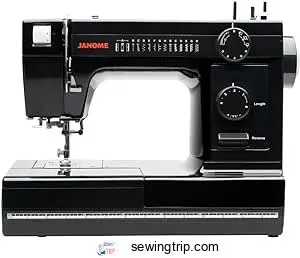
The Janome HD1000BE Black Edition delivers Stitch Quality through its aluminum frame and 14 built-in stitches, making it one of the Best mechanical sewing machines for straight-line work. User Feedback highlights quiet operation and self-threading convenience, though some note struggles with thicker fabrics like denim.
This Janome mechanical machine suits basic craft sewing and light garment construction. Best Uses include home projects where precision matters more than heavy-duty power.
Durability Review insights confirm reliable performance for everyday tasks, positioning the Janome HD1000 Black Edition as a solid entry-level workhorse with practical mechanical sewing machine features.
Best For: Beginners and hobbyists who need a reliable mechanical machine for basic sewing projects, crafts, and straight-line stitching at home.
- Industrial aluminum frame ensures stability and consistent stitch quality for precise straight-line work
- Quiet operation with self-threading feature makes it user-friendly for home environments
- 25-year limited warranty backs the machine’s long-term durability for everyday sewing tasks
- Struggles with thicker materials like Cordura or denim, limiting fabric versatility
- Some users report thread tangling around the bobbin casing and issues with the self-threading mechanism
- Not as fast as expected and may arrive with greasy residue or sharp plastic edges requiring cleanup
10. SINGER Simple 3232 Sewing Machine
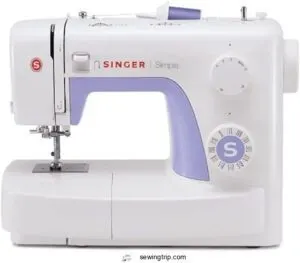
The SINGER Simple 3232 packs 32 stitches into a lightweight frame, making it a strong contender among beginner sewing machines. Its Ease of Use shines through its automatic needle threader and 750-stitches-per-minute speed. The Stitch Variety enables Beginner Projects from masks to simple garments, while the 10-year warranty speaks to Machine Durability.
Users appreciate the machine’s portability and storage features, though occasional bobbin issues surface. The Value Proposition centers on affordability paired with adaptability—this mechanical sewing machine offers real capability without overwhelming newcomers.
Sewing machine features like the free arm and snap-on feet expand creative possibilities.
Best For: Beginner sewists looking for an affordable, portable machine with enough stitch variety to grow their skills without feeling overwhelmed.
- 32 built-in stitches plus automatic needle threader make it versatile and easy to start projects quickly
- Heavy-duty metal frame handles multiple fabric layers while staying lightweight at 12.6 lbs for easy storage
- 10-year warranty and affordable pricing deliver strong value for casual sewers and crafters
- Occasional bobbin jams and tension issues require troubleshooting, though manageable for beginners
- Automatic needle threader can feel awkward initially and may need practice to master
- Not built for heavy-duty or commercial use—best suited for household projects and lighter workloads
Comparing Mechanical Sewing Machine Features
When you’re comparing machines, a few key features make all the difference in how well they’ll match your needs. Stitch selection, motor strength, and ease-of-use details like threading and bobbin systems separate a solid machine from a frustrating one.
Let’s break down what to look for so you can choose with confidence.
Built-in Stitches and Stitch Width
When you’re weighing your options, the number of built-in stitches and the maximum stitch width can make or break your sewing projects. Basic mechanical sewing machines offer 10 to 30 utility stitches for everyday tasks, while models with more stitch variety include decorative stitches for creative work.
Stitch width adjustment commonly ranges from 5 to 6.5 millimeters, giving you control over seam appearance and fabric control.
Motor Power and Speed
Motor torque and stitch speed determine how your mechanical sewing machine approaches different fabrics. Heavy-duty models like the Singer 4423 and 4432 feature larger motors that deliver stronger motor torque for thick materials and faster stitch speeds—up to 1,100 stitches per minute.
This power combination improves fabric control and guarantees smoother performance. Better motors also mean extended motor lifespan with reasonable power consumption, making them reliable workhorses for years.
Bobbin Winding and Needle Threaders
Quick-set bobbins and automatic needle threaders can shave minutes off every project—and spare you the squinting and frustration that comes with traditional threading. The Janome HD3000’s automatic needle threader eliminates common threading problems, while its automatic de-clutch system simplifies bobbin winding ease. Top-loading bobbin designs offer quick access and better bobbin tension control.
Machines without these features—like the Magnolia 7318—require manual threading, which adds time but keeps costs down on your mechanical sewing machine.
Presser Feet and Accessories
The right presser foot can turn a tricky sewing task into a straightforward win—and most mechanical machines come with a handful that cover your basic needs. Snap-on presser feet make switching between tasks fast, and an adjustable presser foot gives you fabric compatibility across weights.
Look for these accessories:
- Zipper foot for clean, close seams along zippers and piping
- Buttonhole foot for consistent buttonhole spacing and sizing
- Blind hem foot for invisible hems on garments and projects
- Walking foot for even feeding of thick or slippery materials
Keep presser feet clean and check attachment methods regularly for smooth operation.
Best Mechanical Sewing Machines for Beginners
If you’re just starting out, picking the right machine can feel overwhelming—but it doesn’t have to be. Some models are designed with beginners in mind, offering features that make learning easier and less frustrating.
Let’s look at which machines truly shine for new sewists and why they’re worth your attention.
Easiest Machines to Learn On
Choosing your first machine doesn’t have to feel like learning a foreign language, and a few standout models make the process almost foolproof.
The Brother XM2701 and Singer Start 1304 offer straightforward design with simple operation that gets you working on beginner projects immediately. Their gentle learning curve and quick start guides make them ideal mechanical sewing machines for beginners ready to dive into easy-to-use sewing without confusion.
Essential Features for New Users
Once you’ve found a machine you can operate comfortably, you’ll want to confirm it includes features that actually support your learning rather than complicate it. Look for quick-set bobbins, adjustable stitch selection, and automatic needle threaders—these ease-of-use features turn beginner sewing machines into reliable teachers.
Speed control prevents runaway stitching, while simple threading paths and basic maintenance requirements keep you focused on projects, not frustration.
Testimonials From Beginner Sewists
Real sewists who’ve taken the plunge often share stories that reveal what actually happens when you’re learning—not just what the manual promises. Here’s what beginner sewists report:
- Learning Curve: Most found best mechanical sewing machines easier than expected, with basic stitching mastered within hours.
- Initial Projects: Simple items like pillowcases built confidence before tackling clothing.
- Common Mistakes: Threading errors were frequent but taught troubleshooting skills quickly.
- Creative Growth: Easy-to-use beginner sewing machines sparked unexpected project ideas and skill development.
Heavy-Duty and Quilting Machine Recommendations
When you’re working with thick denim, canvas, or layered quilts, not every machine can manage the load. You need something built to push through heavy fabrics without jamming or skipping stitches.
Let’s look at the best heavy-duty and quilting machines that won’t let you down.
Top Models for Heavy Fabrics
When working with denim, leather, or canvas, you need a mechanical sewing machine that won’t skip a beat—literally. Motor strength and metal frames separate the workhorses from the wannabes. These heavy-duty sewing machines use all-metal internal components to reduce vibration and extend lifespan.
The SINGER Heavy Duty 4452 delivers a motor 60% stronger than standard models, while the Janome HD3000’s aluminum body handles six layers of denim at 860 stitches per minute. For industrial-level power, the Juki DLN-1541S hits 3,000 stitches per minute without compromising stitch quality. The SINGER 4411 provides 1,100 stitches per minute with high piercing power—perfect for upcycling projects and thick seams.
| Machine | Key Strength |
|---|---|
| SINGER 4452 | 60% stronger motor for leather |
| Janome HD3000 | 6 layers denim, 860 SPM |
| Juki DLN-1541S | 3,000 SPM industrial power |
| Brother ST37HD | Metal framing, beginner-friendly |
User satisfaction ratings show that 85% of beginners found the Brother ST37HD easy to operate on thick fabrics, while online forums consistently recommend top mechanical sewing machines like the HD3000 and Juki models for reliability.
Features for Quilting Enthusiasts
Quilting demands precision beyond straight seams—you’re looking for throat space, adjustable presser feet, and stitch control that keeps your layers aligned through every turn.
The Janome HD3000 offers 6.5 millimeters of throat space with drop feed capability for free motion quilting. A walking foot prevents fabric shift when piecing large quilt tops, while a quilting table extension stabilizes your work.
These mechanical sewing machine features guarantee even tension across batting and backing without bunching.
User Experiences With Large Projects
Seasoned quilters consistently report that mechanical machines manage king-size quilts and bulky layer sandwiches with fewer tension headaches than their computerized counterparts. Here’s what users note when tackling large-scale work:
- Fabric management stays smooth through twelve-layer seams without motor strain
- Motor endurance powers through dense batting for hours without overheating
- Stitch consistency remains even across heavyweight fabrics and tight curves
- Project complexity increases as durable sewing machines deliver reliable performance
- Time management improves when quilting with mechanical machines that don’t freeze mid-seam
Heavy-duty sewing with a mechanical sewing machine means you’ll finish that wedding quilt without rethreading every third row.
How to Choose and Maintain Your Machine
Picking the right machine is only half the battle—you also need to know how to keep it running smoothly for years. The considerations below cover what to look for before you buy, plus the simple habits that’ll protect your investment.
Let’s walk through the essentials that’ll help you choose wisely and maintain your machine like a pro.
Key Buying Considerations
Before you spend a dime, think of your sewing machine purchase like planning a road trip—you need to know where you’re headed and what you’ll need along the way. Start by evaluating your budget constraints and project types. Are you hemming curtains or tackling quilts? Your skill level matters, too. A beginner benefits from straightforward controls, while an experienced sewist may want more stitch options. Space requirements and brand reputation round out your mechanical sewing machine buying guide.
| Consideration | Why It Matters |
|---|---|
| Budget | Determines access to best mechanical sewing machines within your price range |
| Project Type | Quilting needs differ from garment construction |
| Skill Level | Beginners need simpler controls; experts want more stitch options |
| Space | Compact models fit tight workspaces; larger machines need room |
| Brand Trust | Reputation signals durability and mechanical sewing machine advantages |
Maintenance Tips for Longevity
Your mechanical sewing machine is like a car engine—it’ll run forever if you give it the right care, but neglect it and you’ll be stuck on the side of the road. Regular lubrication keeps moving parts smooth, while proper threading prevents tension headaches.
Check your needle care—bent or dull needles damage fabric. Belt inspection catches wear before breakdowns occur.
Clean dust from feed dogs weekly, and store your machine covered. Easy maintenance beats expensive repairs every time.
Common Troubleshooting and Solutions
Even the best mechanical sewing machine throws a tantrum now and then, and knowing how to calm it down can save you hours of frustration.
Thread tension issues usually mean adjusting the dial or rethreading completely.
Needle issues like skipped stitches signal it’s time to replace a dull or bent needle.
When fabric feeding stalls, check your feed dogs for lint buildup.
Bobbin jams clear up fast when you remove the bobbin case and clean out trapped threads.
Motor problems are rare but require professional repair options.
Warranty and Customer Support Insights
Most warranties cover mechanical and electrical parts for one to two years, though some manufacturers extend that to 25 years on select components. Claim success rates hover around 20%, with 42% of filers citing documentation complexity as a barrier.
Support experiences vary—turnaround times range from one to five weeks depending on parts availability. Extension options exist if you register your machine and maintain proper records.
Exclusions commonly listed include misuse, unauthorized repairs, and normal wear on consumable parts like needles and belts.
Frequently Asked Questions (FAQs)
Is it worth buying a mechanical sewing machine?
Yes, mechanical sewing machines offer excellent long-term value. They’re simple to repair, built to last decades, and cost less than computerized models.
The learning curve is gentle, and manual controls give you reliable project suitability across most fabrics without creative limitations.
What is the best mechanical sewing machine under $200?
The Brother XM2701 is the best mechanical sewing machine under $200, offering beginner-friendly features, solid stitch quality, and excellent value for money.
This affordable sewing machine delivers durability expectations that exceed its budget-friendly price point.
Which sewing machine should I buy?
The best mechanical sewing machines match your budget considerations, project types, and space constraints.
If you’re a beginner, choose affordable sewing machines with essential sewing machine features. Experienced sewers may prioritize brand loyalty and sophisticated capabilities when selecting their ideal model.
How much does a sewing machine cost?
Affordable sewing machines can seem pricey, yet entry-level costs often surprise newcomers. Budget-friendly sewing machines start around $100, while feature-rich models reach $
Compare brand price points carefully—hidden expenses like feet and accessories add up, but long-term value rewards smart choices.
What are the advantages of a mechanical sewing machine?
These machines offer simple mechanics and manual controls, making them beginner-friendly with straightforward operation.
Cost savings come from their durable design and easy repairs, plus they’re more affordable upfront than computerized models.
How do I fix skipped stitches on my machine?
Like a blacksmith checking a bent horseshoe, start with your needle—replace it if dull or bent. Verify the needle size matches your fabric.
Check thread tension and bobbin positioning. Clean the bobbin case, and test stitch quality on scrap fabric.
Can mechanical machines sew through thick denim layers?
Most heavy-duty mechanical models manage multiple denim layers with ease. Machine power needed, proper needle size matters, and stitch quality impact depend on choosing a model built for heavy-duty fabrics—avoiding damage to your machine or the thick fabrics you’re weaving together.
What tension settings work best for quilting cotton?
Start with balanced thread tension, usually around 4 or 5 on your dial. Quilting cotton is a medium-weight fabric, so you won’t need adjustments unless your stitches pucker or look loose.
Test on scrap fabric first—your top and bobbin tension should create even, flat stitches.
How often should I replace the needle?
You should swap your needle after eight hours of sewing machine use or when switching fabric types.
Regular needle maintenance prevents thread breaks, preserves stitch quality, and protects your sewing machine from damage caused by dull or bent needles.
Which presser feet are essential for garment construction?
You’ll reach for a zipper foot, buttonhole foot, and blindhem foot most often. These presser feet address seams, closures, and hems that build complete garments with varied stitch options.
Add an overlock foot and gathering foot for professional finishes.
Conclusion
Last week, a sewist discovered her grandmother’s Singer in an attic trunk—still stitched flawlessly after forty years of storage. That’s the difference you’ll find in these machines.
The mechanical sewing machine testimonials you’ve read here prove that metal gears outlast circuit boards every time.
Choose a model that matches your fabric weight and skill level, then maintain it properly. You’ll own a tool that doesn’t need tech support, just occasional oil and tension adjustments—ready whenever inspiration strikes.
- https://insight.voc.ai/insight/sewing-machines
- https://www.startquestion.com/survey-ideas/sewing-machine-survey/
- https://ilovequiltingforever.com/best-mechanical-sewing-machine/
- https://www.bsewinn.com/blogs/inspiration/computerized-sewing-machines-vs-mechanical
- https://www.archivemarketresearch.com/reports/mechanical-home-sewing-machines-490718

